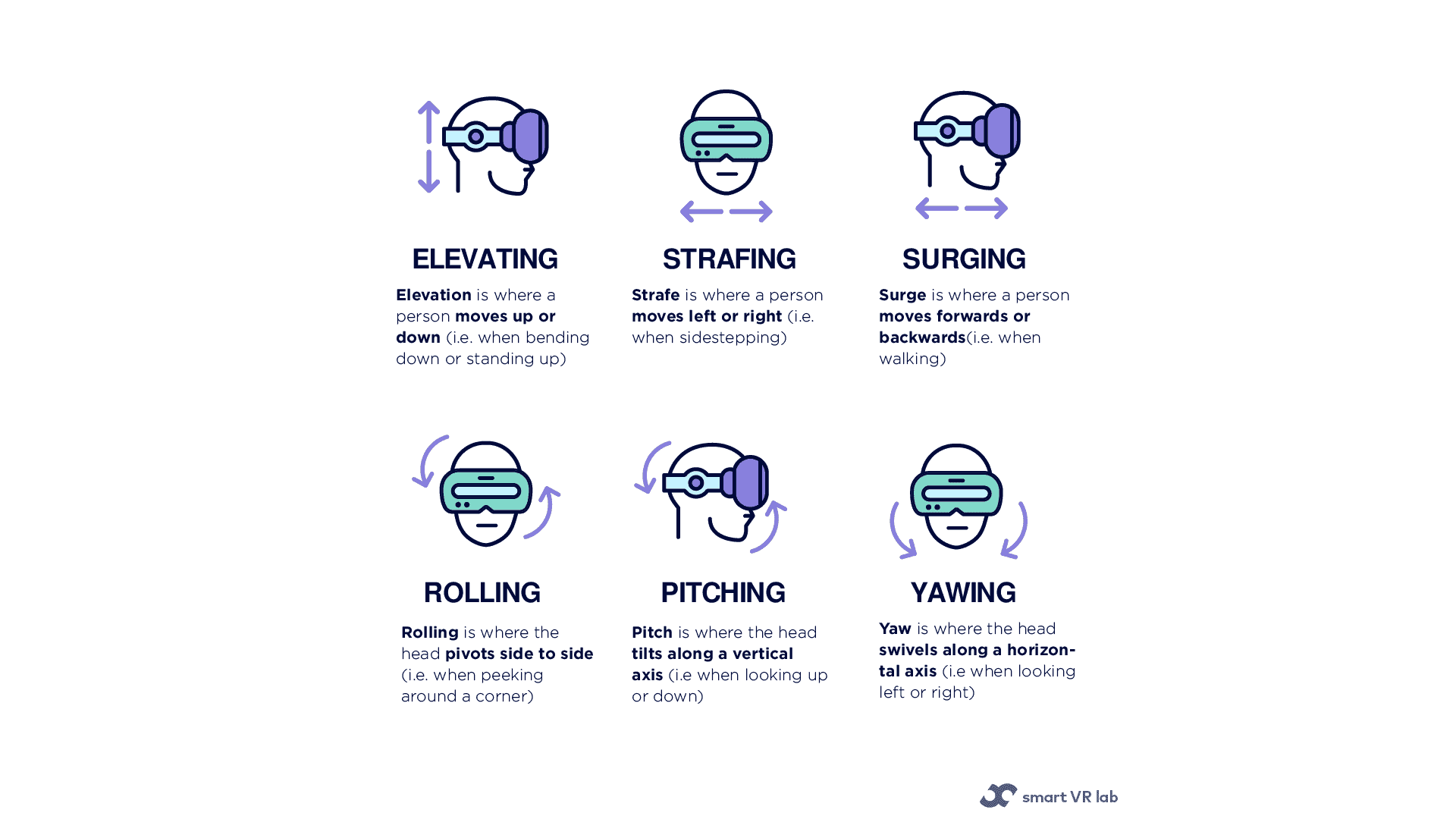In VR, DoF is a common abbreviation that stands for “Degree of Freedom”. The number before it shows how many different axes are being tracked: 3 or 6, 3DoF vs 6DoF. When deciding which type of VR headset to buy, it is essential to consider its DoF tracking capabilities: 3DoF is enough for 360 video, while 3D VR requires 6DoF.
Why is a 3DoF VR sufficient for 360 degree videos? Well, in 360 degree videos, you cannot change the distance to the objects in the room. With 3DoF headsets, you can only move in 3D environments with joysticks, but not your physical motion.
If you want to make use of 3D environments, a 6DoF headset is necessary. It allows for the tracking of your physical movement by the gyroscope additionally – thus enabling virtual movement.
So far so good – yet for an axe-cellent explanation, the axes are still missing. What about them? There are three main axes, the translational ones, and three secondary axes, also known as rotational. Six axes in total.
When a VR device has 3DoF it will either be rotational or translational. But not both. A 6Dof experience, however, allows for both main as well as secondary axes. Therefore, if you want to track both the head and physical body movements, a 6DoF is definitely the best option for you
Rotational axes
Where is your head at? That’s what you can measure on rotational axes! Here again, there are three types of movement, which can be tracked by the movement of the head: rolling, yawing and pitching.
There are three types of movements in rotational axes. They can be tracked by the movement of the head. These movements are known as: rolling, pitching and yawing.
Rolling (X-axis)
Rolling describes the movement of the head from side to side, along the rotational X-axis. How to do it? Try by looking straight-forward, slowly tilt your head to right (with your right ear approaching your right shoulder) and then repeat the same movement to your left side.
They see me rollin’ – and they lovin’!
Yawing (Y-axis)
Yawing is a movement that describes the head swivelling along a horizontal axis, in this case along the rotational Y-axis. Your turn: Look straight-forward, then slowly move your head to face your right (your chin should approach your right shoulder). Now, repeat the same movement in the opposite direction to your left. Yee-yaw!
Pitching (Z-axis)
Here’s a pitch: Look straight-forward, then proceed to slowly move your head along the vertical axis to where your chin approaches your neck. Now, repeat the same movement with your ching moving away from your neck. This movement along the rotational Z-axis is known as pitching.
Translational axes
Let’s get to the main course, the main axes of course: The translational axes. There are three types of movements, which can be tracked by the movement of the body. They are known as: elevating, strafing and surging.
Strafing (X-axis)
Strafing describes the movement along the X-axis, or in other terms, moving sideways in a straight line. Try it out by moving to the left and then to the right in a straight line – you are strafing alright!
Surging (Y-axis)
Surging is when you move front and back in a straight line – the movement along the translational Y-axis, so to say. This can be done by taking steps forward or backwards in a straight-line.
Elevating (Z-axis)
Elevating is when you move your body vertically along the Z-axis. Well, it is in elevated terms. In practice, it can be done by jumping up and down or crouching and then getting back up. What an elevated experience.
3DoF vs 6DoF?
So in summary, we need to axe-cept that the main difference between 3DoF vs 6DoF is that with 6DoF, you can track rotational as well as transitional axes. The superior choice in many ways, as you can do more and do it more seamlessly without the hassle of being confined to joysticks. So go with 6DoF – unless you are planning on only using and consuming content that doesn’t need the full range of the DoF (aka 360 degree videos).
If you made it this far, congrats! You now officially graduated from your Degree on DoF, Degrees of freedom. So now you have the freedom to explore and learn even more about Virtual Reality!
More apps are being released daily for business training purposes. Smart VR Lab is a VR CMS platform mainly focused on video content, with it’s platform you can access 3D environments. To transform the way your business trains its staff, simply contact Smart VR Lab for a demo and set up a meeting with our team.
Request a VRee trial
For a free 4-week trial, demo or simply more information,please leave your email.

